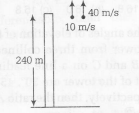Answer:
Option C
Explanation:
Central idea. concept of relative motion can be applied to predict the nature of motion of one particle with respect to the other.
Consider ,the stones thrown up simulaneously as shown in the diagram below.
Considering motion of the second particle with respect to the first we have realtive acceleration
$|a_{21}|=|a_{2}-a_{1}|=g-g=0$

Thus, motion of first particle is straight line with respect to second particle till the first particle strikes ground at a time given by
$-240=10t-\frac{1}{2}\times 10\times t^{2}$
or $t^{2}-2t-48=0$
or $t^{2}-8t+6t-48=0$
or t=8,-6 (not possible)
Thus, distance covered by second particle with respect to first particle in 8 s is
$s_{12}=(v_{21})t=(40-10)(8s)$
$=30\times 8=240m$
Similarly, time taken by second particle to strike the ground is given by
$-240=40t-\frac{1}{2}\times10\times t^{2}$
or $-240=40t-5 t^{2}$
or $5 t^{2}-40t-240=0$
or $ t^{2}-8t-48=0$
$ t^{2}-12t+4t-48=0$
or t (t-12)+4(t-12)=0
or t=12,-4 (not possible)
Thus, after 8 s, magnitude of relative velocity will increase up to 12 s when second particle strikes the ground.